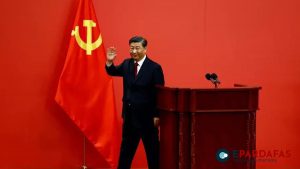
Nepal-China Joint Statement Raises Concerns About Tibetan Affairs
The joint statement released by Nepal and China on September 26, 2023, following the visit of Prime Minister Pushpa Kamal Dahal ‘Prachanda’, has raised concerns regarding China’s influence on matters relating to Tibet and Tibetans.
International Campaign for Tibet President Tencho Gyatso emphasized that Nepal is obliged by international law to uphold the principle of non-refoulement, which prohibits states from returning individuals to places where they may face torture or persecution. This principle is enshrined in several treaties ratified by Nepal, including the Convention against Torture and Other Cruel, Inhuman, or Degrading Treatment or Punishment (Article 3), General Comment No. 20 of the Human Rights Committee, and General Comment No. 6 of the Committee on the Rights of the Child.
The joint statement, comprising 13 points, includes four significant references to Tibetan affairs, encompassing political, boundary management, health, and infrastructural matters.
Politically, the statement reaffirms that “Tibet affairs are China’s internal affairs” and that Nepal will not permit any separatist activities against China on its soil. This phrasing is distinct from previous joint statements in 2019 and 2018, which included Tibet and Taiwan under the umbrella of the one-China policy.
Of particular concern is the agreement on boundary management, which could affect Tibetans attempting to flee through Nepal and the potential deportation of those already in Nepal. The joint statement indicates that the “two sides agreed to bring into force” the “Agreement Between the Government of the People’s Republic of China and the Government of Nepal on the Boundary Management System” as soon as possible. This agreement provides additional avenues for China to deport Tibetans from Nepal to Tibet.
Articles 26 and 27 of the agreement address “persons crossing the border illegally.” Article 26.2 specifies that border representatives or competent authorities from both sides shall investigate such cases, ascertain identities, and cross-border facts and reasons, then hand over the individuals to the side where they resided before crossing the border within seven days of detention. This agreement poses a risk to the very few Tibetans who manage to cross into Nepal, as they could be effectively returned to Tibet without legal protection.
Furthermore, the agreement allows Chinese authorities to obtain information from Nepal regarding those fleeing Tibet. Article 26.5 effectively obligates Nepal to provide China with evidence of cross-border activities and the means of communication used by individuals crossing the border.
The agreement also expands on the use of firearms to deal with individuals crossing the border illegally. Article 27 stipulates that frontier personnel must issue warnings before using weapons, limiting weapon use to preventing unlawful actions only.
In a concerning development, the joint statement makes no mention of the previously discussed extradition treaty, which had raised concerns about the potential arrest and return of long-term Tibetan residents in Nepal.
The statement also addresses the opening and reopening of transit points along the Tibetan border and mentions the rail link between Kyirong in Tibet and Kathmandu, although no progress appears to have been made on these initiatives. Additionally, China’s designation of “Xizang” in English to refer to “Tibet” in the joint statement is noteworthy.
Prime Minister Dahal is expected to visit Tibet, possibly on September 29, before returning to Nepal, despite the joint statement’s release on September 26.













Comments